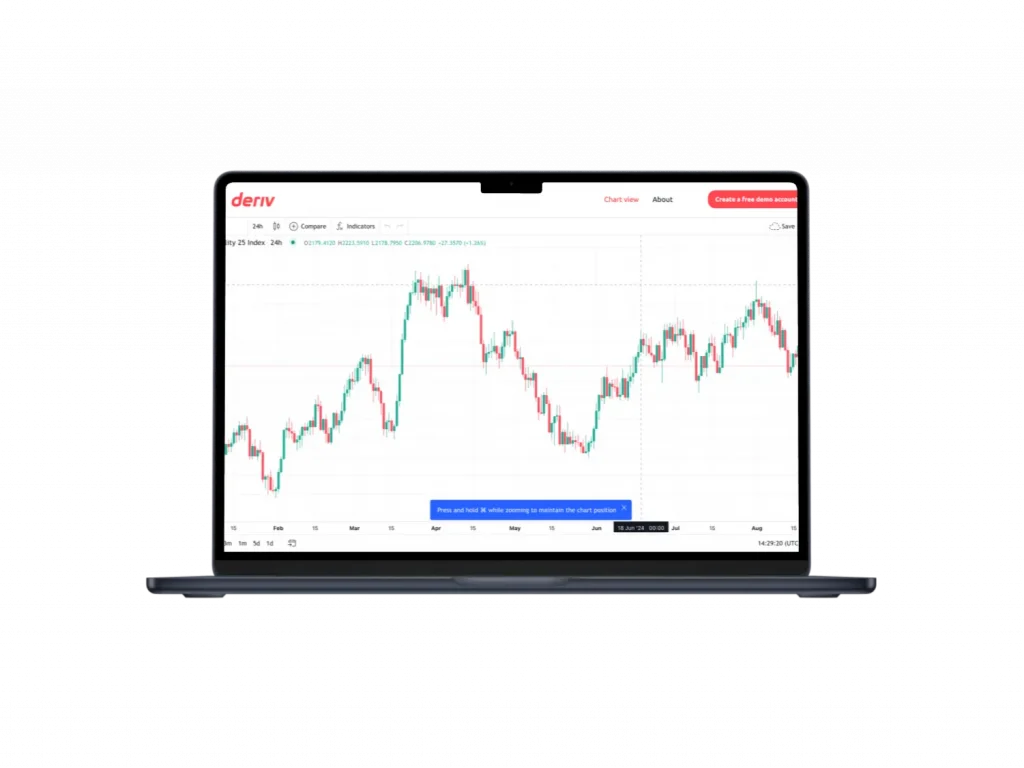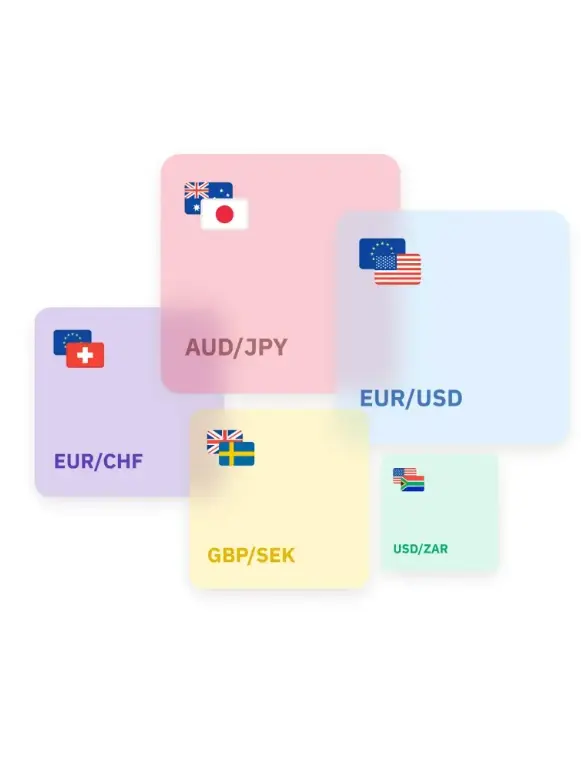Deriv South Africa: tools and techniques for investing in Nvidia (NVDA) shares
Best for 25 years
⭐⭐⭐⭐⭐

Home » NVDA
Nvidia Corporation is an American technology company specializing in the development of graphics processors and chips for mobile devices. Founded in 1993, its headquarters is located in Santa Clara, California.
Main areas of activity:
- Graphics Processing Units (GPU)
- System-on-Chip (SoC)
- Solutions for artificial intelligence and machine learning
- Technologies for autonomous vehicles
- Stock ticker on NASDAQ: NVDA
Key product lines:
- GeForce (gaming GPUs)
- Quadro (professional GPUs)
- Tesla (GPUs for data centers)
- DRIVE (platform for autonomous vehicles)
- Jetson (platform for robotics and IoT)
Financial highlights (latest fiscal year):
- Revenue: $26.91 billion
- Net Income: $4.33 billion
- Market Capitalization: over $500 billion

Why Investors Choose Nvidia Stock
- Leadership in the GPU industry
- Market share of discrete GPUs: over 80%
- Constant innovation and release of new architectures
- Strong position in the AI market
- Development of specialized chips for AI computing
- Partnerships with leading tech companies
- Growth potential in the autonomous vehicle sector
- DRIVE platform used by many car manufacturers
- Development of technologies for autonomous transportation
- Stable financial performance
- Consistent revenue and profit growth
- High business profitability
- Innovative product development approach
- Significant investments in R&D
- Regular updates to product lines
Table: Comparison of Nvidia with Competitors
Metric | Nvidia | AMD | Intel |
GPU Market Share | 80%+ | 19%+ | <1% |
Revenue (billion $) | 26.91 | 16.43 | 79.02 |
Net Income (billion $) | 4.33 | 1.32 | 8.01 |
P/E Ratio | 90.5 | 45.3 | 15.2 |
Revenue Growth (YoY) | +61% | +68% | -7% |
How to Invest in Nvidia Stock via Deriv
Deriv offers several ways to invest in Nvidia stock:- CFDs on Stocks
- Trade without owning physical shares
- Leverage available
- Ability to trade both long and short
- Commission: 0.15% of the transaction volume
- Leverage: up to 1:20
- Digital Options
- Predict the price movement of the stock
- Fixed risks and potential returns
- Short expiration times
- Minimum stake: $1
- Maximum payout: up to 1000%
- Multipliers
- Increased potential profits
- Automatic stop-loss to limit risks
- Intraday trading
- Multipliers: x20, x40, x60, x100
- Minimum amount: $1
| Feature | CFDs | Digital Options | Multipliers |
| Ownership of Shares | No | No | No |
| Leverage | Up to 1:20 | None | Fixed |
| Trade Duration | No limits | From 1 min to 1 day | Intraday |
| Risk | Unlimited | Limited | Limited |
| Potential Profit | Unlimited | Up to 1000% | Depends on multiplier |
Analyzing Nvidia Stock Before Investing
- Fundamental Analysis:
- Study the company’s financial reports
- Quarterly and annual reports
- P/E, P/S, EPS ratios
- Revenue and profit trends
- Evaluate market share and competitive position
- Comparison with AMD, Intel, and other manufacturers
- Analysis of the patent portfolio
- Analyze Nvidia’s news and press releases
- Announcements of new products
- Partnerships and contracts
- Comments from company management
- Study the company’s financial reports
- Technical Analysis:
- Use charts and indicators on the Deriv platform
- Candlestick charts
- Trend lines
- Moving Averages (MA)
- Relative Strength Index (RSI)
- MACD
- Identify support and resistance levels
- Analyze trend and volatility
- Determine short-term and long-term trends
- Calculate historical volatility
- Use charts and indicators on the Deriv platform
- Industry Analysis:
- Evaluate the prospects of the GPU and AI markets
- Market growth forecasts
- Technological trends
- Study competitors (AMD, Intel)
- Compare product lines
- Analyze financial performance
- Assess regulatory risks
- Antitrust laws
- Export restrictions
- Evaluate the prospects of the GPU and AI markets
- Macroeconomic Analysis:
- Impact of economic cycles on the tech sector
- Analysis of interest rates and their effect on company valuation
- Geopolitical factors affecting supply chains

Opening an Account on Deriv to Trade Nvidia Stock
- Go to the official website Deriv.com
- Click the “Create Free Account” button
- Fill out the registration form
- Enter personal details
- Select account currency
- Create a strong password
- Confirm email and phone number
- Complete identity verification
- Upload a scan of your passport or ID
- Provide proof of address
- Fund your trading account
- Minimum deposit: $5
- Available methods: bank transfer, credit cards, e-wallets
Additional steps:
- Set up two-factor authentication for enhanced security
- Familiarize yourself with the platform using a demo account
- Study Deriv’s educational materials on stock trading
Analyzing Nvidia Stock Before Investing
- Fundamental Analysis:
- Study the company’s financial reports
- Quarterly and annual reports
- P/E, P/S, EPS ratios
- Revenue and profit trends
- Evaluate market share and competitive position
- Comparison with AMD, Intel, and other manufacturers
- Analysis of the patent portfolio
- Analyze Nvidia’s news and press releases
- Announcements of new products
- Partnerships and contracts
- Comments from company management
- Study the company’s financial reports
- Technical Analysis:
- Use charts and indicators on the Deriv platform
- Candlestick charts
- Trend lines
- Moving Averages (MA)
- Relative Strength Index (RSI)
- MACD
- Identify support and resistance levels
- Analyze trend and volatility
- Determine short-term and long-term trends
- Calculate historical volatility
- Use charts and indicators on the Deriv platform
- Industry Analysis:
- Evaluate the prospects of the GPU and AI markets
- Market growth forecasts
- Technological trends
- Study competitors (AMD, Intel)
- Compare product lines
- Analyze financial performance
- Assess regulatory risks
- Antitrust laws
- Export restrictions
- Evaluate the prospects of the GPU and AI markets
- Macroeconomic Analysis:
- Impact of economic cycles on the tech sector
- Analysis of interest rates and their effect on company valuation
- Geopolitical factors affecting supply chains
Investment Strategies for Nvidia Stock
- Long-term Investment:
- Buy and hold shares for the long term
- Focus on the company’s fundamentals
- Reinvest dividends (if paid)
- Investment horizon: 3-5 years and beyond
- Regularly review the position (quarterly or semi-annually)
- Short-term Trading:
- Use technical analysis to enter and exit positions
- Trade on company news and events
- Use stop-loss and take-profit orders
- Trading horizon: from a few minutes to a few days
- Actively manage positions
- Hedging:
- Use options to protect positions
- Buy put options to protect long positions
- Sell call options for additional income
- Diversify the portfolio with other tech stocks
- Use market-neutral strategies
- Pair trading (e.g., Nvidia vs. AMD)
- Delta-neutral options strategies
- Use options to protect positions
- Event-driven Investing:
- Trade before and after earnings reports
- Invest based on new product announcements
- React to changes in company management
- Position Averaging:
- Regularly invest a fixed amount
- Reduce the impact of market volatility
- Long-term position accumulation
Common Issues
- Issue: High volatility of Nvidia stock
- Solution:
- Use stop-losses to limit potential losses
- Diversify your portfolio, avoid concentrating solely on Nvidia stock
- Consider using options strategies for hedging risks
- Solution:
- Issue: Difficulty analyzing the tech sector
- Solution:
- Study Deriv’s educational materials on fundamental and technical analysis
- Follow industry news and analyst reports
- Use Deriv’s demo account for practice analysis and trading without risking real funds
- Solution:
- Issue: Uncertainty about the timing of entering a position
- Solution:
- Use technical analysis tools on the Deriv platform to identify support and resistance levels
- Consider a position averaging strategy, spreading investments over time
- Monitor Nvidia’s corporate events that could impact stock prices
- Solution:
FAQ
The minimum investment amount depends on the chosen instrument:
- For CFDs on stocks: from 0.01 lots (equivalent to 1% of the stock price)
- For digital options: from $1 or equivalent in another currency
- For multipliers: from $1 or equivalent
Exact values may vary, so it is recommended to check the current terms in the instrument specifications on the Deriv platform.
To protect investments, the following methods can be used:
- Setting stop-losses on open positions
- Using options strategies, such as buying put options
- Diversifying the portfolio by including other company stocks or asset classes
- Hedging positions using derivative instruments
- Regularly monitoring news and the company’s financial performance to make timely decisions
When trading CFDs on Nvidia stock through Deriv, you do not own the physical shares, so direct dividend payments are not available. However, Deriv accounts for dividends as follows:
- For long positions: an amount equivalent to the dividends is credited to the trader’s account
- For short positions: an amount equivalent to the dividends is deducted from the trader’s account









